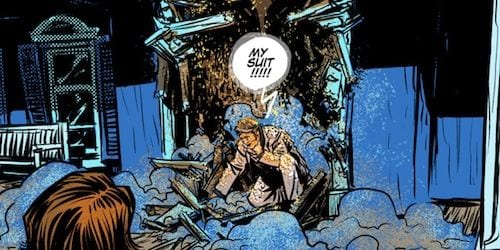
With issue five, Image Comic’s pulpy series Blue Estate is approaching the midpoint of its 12-issue run. The previous issue had its shocking parts that were mundanely fun, but as opposed to earlier issues, was very much a slow down point. The character development and further establishment of the comic’s aesthetic and tone were the highlights. Now issue five is here to pick up the action.
The idea behind Blue Estate is to take all of the stereotypes, clichés and conventions of modern noir and let them run loose in a celebrity obsessed culture to see what happens. That’s not to say that the story isn’t a tight narrative, but rather that the inspiration derives from the seedy side of our society. The side that is addicted to TMZ and E! True Hollywood Stories.
It’s a complex story to be sure, one that’s playing out over 12 issues without any padding. The complicated and intertwined relationships between all of the characters – which include Italian and Russian mobsters, a bumbling private eye, burnt out slackers, washed up movie stars, strippers and a scheming real estate investor – is a whirlwind of dialogue and plot details. Keeping it all straight can be a challenge.
From tough guys in bizarre situations to the nonlinear narrative, Blue Estate is a mix of Quentin Tarantino and Guy Ritchie films, with a generous helping of Elmore Leonard novels and a twist of absurdist comedy. It’s an unabashed send up of crime fiction with a cinematic eye that stretches the conventions of comic book storytelling. And while Blue Estate has already revealed all of its storytelling tricks – changing artists to show different perspectives and moments in time – those tricks are still an effective means to execute such a layered and ambitious tale.
Rachel Maddox, the starlet wife of has been action star Bruce Maddox, and her ne’er-do-well brother Billy are both in trouble…but for different reasons and with different people. Meanwhile Italian mobster Tony is getting impatient with his get rich quick real estate scheme. Add to that Bruce’s ties to the Russian mob and manipulation of clueless private eye Roy Devine, Jr., and you have the making for an issue that is Blue Estate’s most noir heavy to date – yet oozing with absurdist comedy and shenanigans.
Creator and artistic director Viktor Kalvachev and writer Andrew Osborne again fill this issue with so many pulp and noir clichés that it may take several reads to pick up all of the jokes. Yet for all the comedy, there is a serious tale unfolding, and one with dangerous consequences.
The art team including Toby Cypress, Nathan Fox, Paul Maybury, Marley Zarcone and Kalvachev on colors delivers the fully cemented aesthetic and style of Blue Estate with ease. The shifts in pencilers have only become easier to follow from issue to issue. Here, the subtle and at times striking differences in pencil work are an asset – unlike other books where the different pencilers are employed to meet deadlines. The blending of panels comes from Kalvachev’s color work. Early on the color palette was strict, utilizing various shades of oranges, blues and blacks. As the story has moved from issue to issue, the colors have expanded, loosening their tight grip on the visual narrative as to allow the full potential of the creative team to accentuate the long list of characters and time periods. It’s not a conspicuous shift as Kalvachev et al has prepared their audience for this in the pages of each issue. It’s helpful, as the movements between colors and pencils are smooth yet noticeable.
With each issue Blue Estate continues to impress. The patience of its creators to tell their complex and involved story within the boundaries they have set is inspiring. It’s completely plausible to level criticism that the book is all sketchy style, but that would dismiss the multifaceted narrative that is a studious exploration of noir clichés, as well as a prime example of the heights modern-noir can achieve. The book is not for the timid by any means. It is not a heady trip into the existential mires of contemporary life, but it does require a certain amount of studiousness to fully embrace all of the strange caricatures. Stories like this one shouldn’t come easy.
